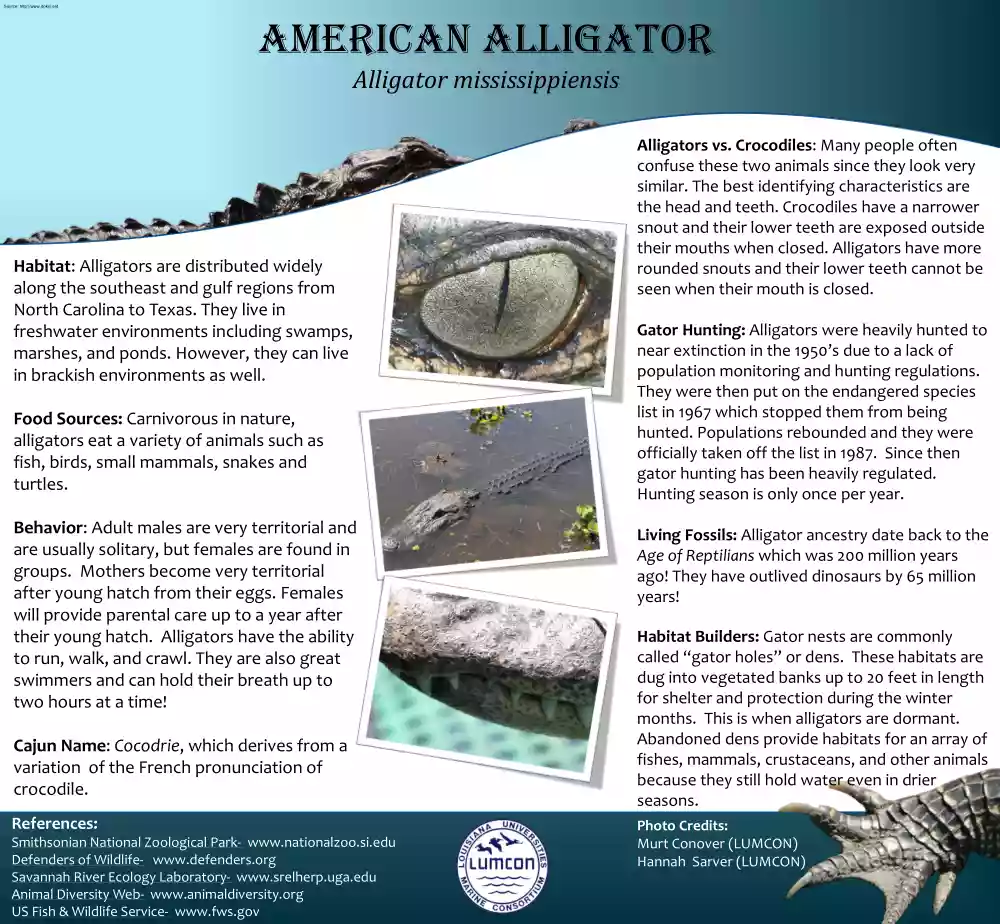Please log in to read this in our online viewer!

Please log in to read this in our online viewer!
No comments yet. You can be the first!
What did others read after this?
Content extract
Source: http://www.doksinet American Alligator Alligator mississippiensis Habitat: Alligators are distributed widely along the southeast and gulf regions from North Carolina to Texas. They live in freshwater environments including swamps, marshes, and ponds. However, they can live in brackish environments as well. Food Sources: Carnivorous in nature, alligators eat a variety of animals such as fish, birds, small mammals, snakes and turtles. Behavior: Adult males are very territorial and are usually solitary, but females are found in groups. Mothers become very territorial after young hatch from their eggs. Females will provide parental care up to a year after their young hatch. Alligators have the ability to run, walk, and crawl. They are also great swimmers and can hold their breath up to two hours at a time! Cajun Name: Cocodrie, which derives from a variation of the French pronunciation of crocodile. References: Smithsonian National Zoological Park- www.nationalzoosiedu Defenders
of Wildlife- www.defendersorg Savannah River Ecology Laboratory- www.srelherpugaedu Animal Diversity Web- www.animaldiversityorg US Fish & Wildlife Service- www.fwsgov Alligators vs. Crocodiles: Many people often confuse these two animals since they look very similar. The best identifying characteristics are the head and teeth. Crocodiles have a narrower snout and their lower teeth are exposed outside their mouths when closed. Alligators have more rounded snouts and their lower teeth cannot be seen when their mouth is closed. Gator Hunting: Alligators were heavily hunted to near extinction in the 1950’s due to a lack of population monitoring and hunting regulations. They were then put on the endangered species list in 1967 which stopped them from being hunted. Populations rebounded and they were officially taken off the list in 1987. Since then gator hunting has been heavily regulated. Hunting season is only once per year. Living Fossils: Alligator ancestry date back to the Age
of Reptilians which was 200 million years ago! They have outlived dinosaurs by 65 million years! Habitat Builders: Gator nests are commonly called “gator holes” or dens. These habitats are dug into vegetated banks up to 20 feet in length for shelter and protection during the winter months. This is when alligators are dormant Abandoned dens provide habitats for an array of fishes, mammals, crustaceans, and other animals because they still hold water even in drier seasons. Photo Credits: Murt Conover (LUMCON) Hannah Sarver (LUMCON)
of Wildlife- www.defendersorg Savannah River Ecology Laboratory- www.srelherpugaedu Animal Diversity Web- www.animaldiversityorg US Fish & Wildlife Service- www.fwsgov Alligators vs. Crocodiles: Many people often confuse these two animals since they look very similar. The best identifying characteristics are the head and teeth. Crocodiles have a narrower snout and their lower teeth are exposed outside their mouths when closed. Alligators have more rounded snouts and their lower teeth cannot be seen when their mouth is closed. Gator Hunting: Alligators were heavily hunted to near extinction in the 1950’s due to a lack of population monitoring and hunting regulations. They were then put on the endangered species list in 1967 which stopped them from being hunted. Populations rebounded and they were officially taken off the list in 1987. Since then gator hunting has been heavily regulated. Hunting season is only once per year. Living Fossils: Alligator ancestry date back to the Age
of Reptilians which was 200 million years ago! They have outlived dinosaurs by 65 million years! Habitat Builders: Gator nests are commonly called “gator holes” or dens. These habitats are dug into vegetated banks up to 20 feet in length for shelter and protection during the winter months. This is when alligators are dormant Abandoned dens provide habitats for an array of fishes, mammals, crustaceans, and other animals because they still hold water even in drier seasons. Photo Credits: Murt Conover (LUMCON) Hannah Sarver (LUMCON)




